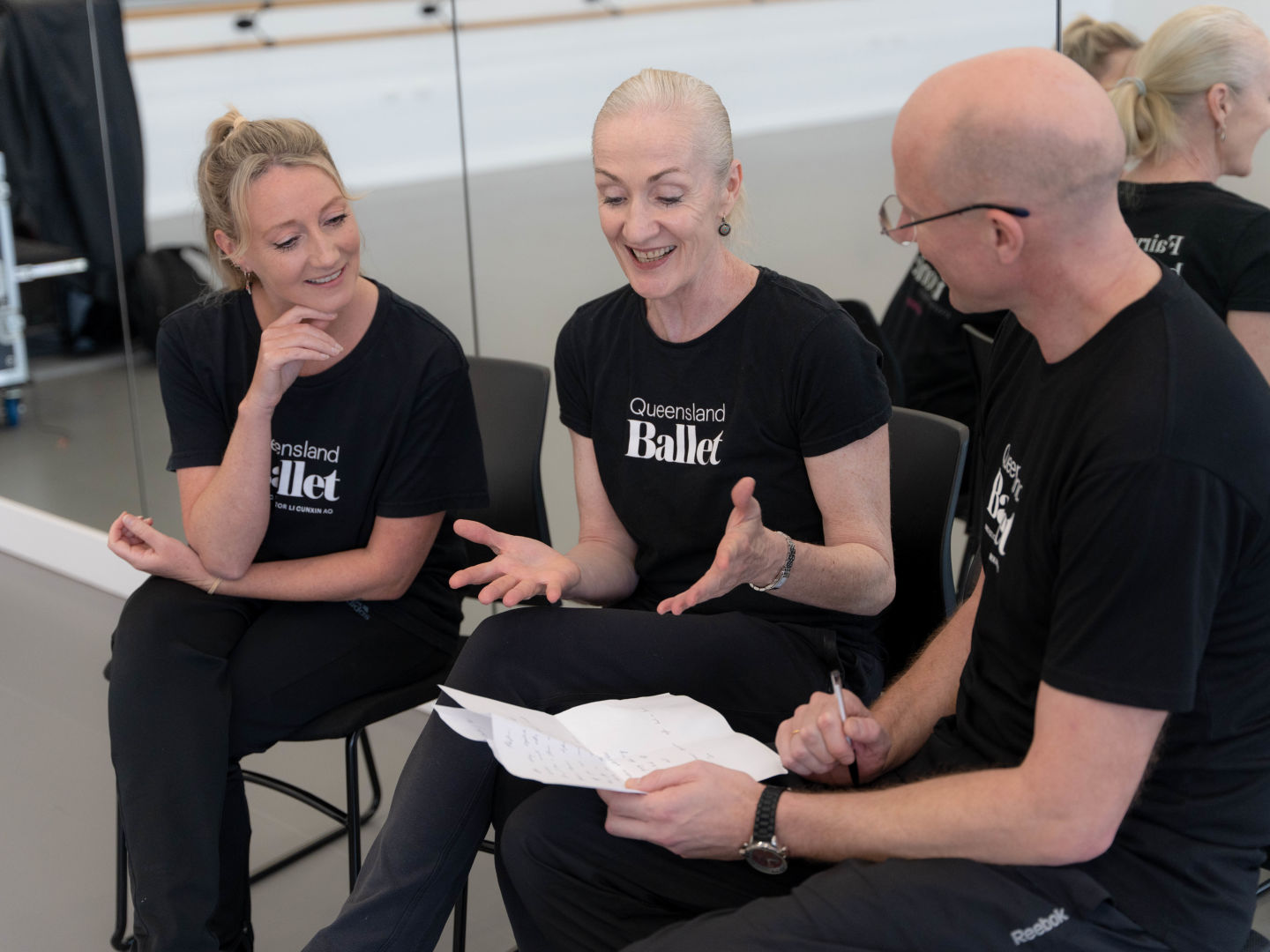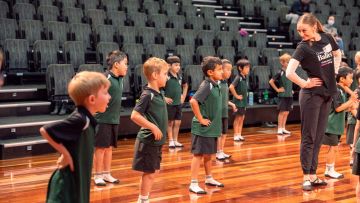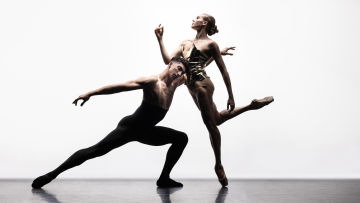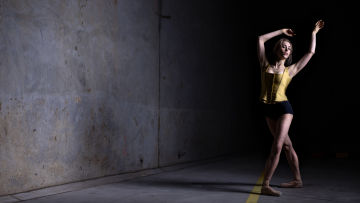Meet the Queensland Ballet Academy Contemporary team

Ask a dancer what they love about contemporary dance, and most will mention the freedom of creative expression, fluidity of movement, or opportunity for emotive storytelling. But as more professional choreographers involve dancers in their creative process when creating new works, there’s a practical reason to love it too. Meet the contemporary teachers and students who are blazing through the industry with Queensland Ballet Academy’s new Transitional Course, dedicated to career preparation and skill development in the contemporary sphere.
Brisbane, Sydney and Melbourne auditions for 2023 closing soon!
How has your background and experience prepared you for teaching the Transitional Course and contemporary classes?
Louise Deleur, Head of Contemporary Dance and Resident Choreographer: Although I have come from a strong classical background, my interest in contemporary dance was inspired in my early training years working with Leigh Warren and Graeme Murphy. Then during my time with Sydney Dance Company, my colleagues and I did some fantastic collective work within and outside the company. It’s this creative spirit and the eclectic attitudes that I find so inspiring, and probably underlines the values of how I work now. Other guesting roles and study, including studying Pilates in New York, gave me a strong understanding of body mechanics and movement efficiency.
Prior to my position as a Head of Program at QB Academy, I wrote several courses for contemporary technique; started Australia’s first private, dedicated contemporary dance course, self-produced and toured several Company works, and I am the founder and Director of the Brisbane International Contemporary Dance Prix.
Grant Aris, Associate Teacher: After training at the Royal Ballet School, White Lodge; and the Australian Ballet School, my focus at the beginning of my career was purely classical. It was upon working with Meryl Tankard and performing a ballet from Maurice Béjart, with The Australian Ballet, that my vision of contemporary dance and the dimensions of alternative and diverse creative movements opened up to me. This is the main reason why I chose to further develop my understanding of diverse repertoire, and ventured to Europe. After dancing numerous pieces from world-renowned choreographers with Le Ballet du Grand Theatre de Geneve, I was appointed the role of Ballet Master and Rehearsal Director for the company and maintained the position for 13 years where I had the fortunate opportunity to work with many creative minds.
It was always my dream to return to Australia one day with the wealth of dance knowledge and to nurture the next generation of dancers in Australia with a broader curiosity to dance, and this experience has prepared me to highlight the diversity of dance to the new Transitional Course dancers.
Amelia Waller, Associate Teacher: My love of contemporary dance really developed as a Soloist with Queensland Ballet. Not only were we fortunate to work with a range of Australian and international choreographers but we were exposed to some of Europe’s greatest dancers and contemporary works. Exposure to such innovative, diverse pieces ignited my curiosity to move to Europe where I danced as soloist with the Leipzig Ballet company in Germany, under the direction of Mario Schroeder. In Europe, I had the opportunity to work with many choreographers and artists who each had a unique creative process; for example, when working with Batsheva’s director Ohad Naharin, we took daily Gaga classes in order to fully understand his movement vocabulary.
These past experiences, both in Australia and Internationally have helped shape my teaching methods at the Academy. I always aim to incorporate a range of styles and improvisational techniques to ensure our students are versatile, creative, have a varied skillset and are prepared for the professional dance industry.
What can students expect in a typical day?
Louise: The program runs alongside the Upper School ballet course, with our Transitional Course having their own ballet, contemporary, duo, yoga and improvisation classes. They join with the other Upper School dancers for additional studies and body conditioning sessions. Classes run from 8am to 1.15pm six days a week with the students completing academic studies at Kelvin Grove State College each weekday afternoon
Grant: The students are extremely fortunate to have a wide range of classes and teachers available to them. The Transitional Course is more focused on exploring a wide range of dance techniques. I am currently teaching the dancers contemporary technique, contemporary repertoire, improvisation, and partnering technique.
How will the contemporary creative process help the students develop into stronger dancers?
Louise: In developing the creative skills in a dancer, I first wish to develop their own confidence and abilities to explore movement, to trust themselves, and to develop their maturity as artists along with the skills to contribute to creative processes. These days, more choreographers rely on the creative input of the dancers to create works and being able to work confidently with a choreographer in a professional environment is a very valuable skill.
Grant: With the extraordinary wisdom and talent from Louise Deleur, we aim to create an artistic approach in their classes. I believe that self-acceptance in being a unique individual is a priority in becoming an artist in the dance world today, and we strive to guide the dancers to be aware of every diverse element of dance that may help them to develop into the artists of tomorrow.
Amelia: When a dancer is given certain choreographic or improvisational tasks, they often discover something new about themselves - be it physical or emotional. I feel it is this kind of exploration that helps students develop into well-rounded artists who can adapt to a variety of styles and more importantly bring a choreographer's vision to fruition.
Highlights from this inaugural year of the Transitional Course so far?
Louise: Firstly, it has been gathering the team, as I’m really delighted with their energy, spirit, creativity, talent and knowledge – the environment in the studio has been fantastic. Seeing the dancers hungry for more, and excited to challenge themselves is also very rewarding. With more performances coming up this year, I’m excited to see them onstage to watch their continued maturity and development.
Grant: For me personally, this year's highlight has been able to work with such a wonderful team of colleagues and also to have opportunity to teach and encourage such a talented and devoted group of young artists.
Madeleine Semple and Fleur Evans are in the first cohort of dancers studying the Transitional Course this year. We also sat down with them to ask what they love about it.
What Attracted you to the course?
Madeleine: It allows us to explore contemporary repertoire in depth, while also refining both ballet and contemporary technique and line. The course supports us to develop as people as well as dancers. There’s also the amazing faculty: they bring a wealth of knowledge to our contemporary training alongside the incredible classical faculty and wellbeing support experts who provide a well-rounded experience.
Fleur: I was attracted to the opportunity to explore a different pathway, whilst working alongside talented and passionate faculty members. I found it a challenge to conform to the technical demands of the classical ballet genre, however the freedom to express myself more fluidly, whilst maintaining a strong classical foundation, aligns more holistically with my strengths. The neo-classical and contemporary genres are just as challenging as ballet, I believe, and so I find it equally rewarding.
Favourite aspect of the course so far?
Madeleine The emphasis on developing as an artist as well as building strength and technical proficiency. Whilst our teachers are very clear about technical guidance and improvements when it comes to our movement, they are also very encouraging in finding the flow and freedom to explore movements in our own way. Another aspect I’m enjoying is the focus on creativity and choreography. This is an area I am still building confidence in, and the teachers have been so encouraging in guiding me to step outside my comfort zone.
Fleur: I have really valued working collaboratively with Louise and Grant in the studio to create performance pieces. The positive and encouraging atmosphere these teachers create in rehearsals truly inspires us as a team to create, develop, and refine movement.
Being new to the Academy, how have you found this program different from other training experiences?
Madeleine: I find the Transitional Course unique in the way we receive a well-rounded contemporary dance education in a structured program that nurtures us as artists. I feel as though our teachers greatly value the importance of correct technique alongside the sense of freedom. Additionally, versatility is something that is focused on throughout this course. Initially I was attracted to the course because I have a classical background but knew I wanted to go more down the contemporary path, so it’s a good way for me to learn new skills while maintaining the training I grew up with. The career preparation class has also helped us to gain a broader knowledge of the dance world, and to focus on what we want our careers to look like.
As someone who has come through the Upper School ballet course, how do you find the Transitional Course compared to last year’s program?
Fleur: Alongside our strong classical foundation, we are given the freedom to move in a more artistic manner as we pursue a career in the contemporary or neo-classical industries. These industries tend to look for dancers who can travel through space with ease, grace, and a fluid dynamic. While our week consists of less ballet and pointe classes, we learn to present our fluidity in our open ballet classes in preparation for company auditions. We also explore contemporary partnering where we are challenged to trust each other and rely on improvisation techniques to connect with one another in an effortless manner.
What do you hope to get out of it?
Fleur: My primary goal entering the course was to develop my strength in contemporary dance, and to discover what movement style suits me as I begin auditioning for junior companies. I believe this course is preparing me to explore contemporary dance opportunities throughout Europe, learning what the industry demands of us. Louise’s dedication to every one of her students has supported us to connect with our strengths and weaknesses in an effort to truly discover who we are as a dancer.
Madeleine: More confidence in my creativity and ability to go for something and just try new things in dance. I also hope to continue developing skills in picking up contemporary movement and translating it into my body, by understanding in more detail the way my body moves, and the coordination required for key steps. As well, I want to gain a broader knowledge of the contemporary world and more of an insight into what is expected of dancers by different companies and what I can expect from a career in the contemporary industry. Being six months into the course already, I feel as though I have begun to explore all three of these aspects and will only continue to grow further as a dancer in the next six months.
#Related

Media - Press Releases
Queensland Ballet Education Programs 2026 Learning through Dance

Media - Articles
2025 Wrap Up

Media - Press Releases
